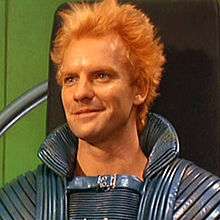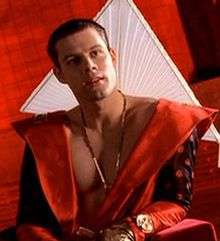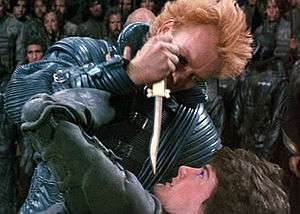Feyd-Rautha
| Feyd-Rautha Harkonnen | |
|---|---|
| Dune character | |
 | |
| First appearance | Dune (1965) |
| Last appearance | Dune: House Corrino (2001) |
| Created by | Frank Herbert |
| Portrayed by | |
| Information | |
| Affiliation | House Harkonnen |
| Title | na-Baron |
| Children | Marie Fenring |
| Relatives |
|

The na-Baron Feyd-Rautha Harkonnen is a fictional character in the 1965 science fiction novel Dune by Frank Herbert.
The younger nephew of the cruel, powerful and cunning Baron Vladimir Harkonnen,[1] the dark-haired, 16-year-old Feyd[2] is as lean and muscular as the Baron is morbidly obese;[3] the Baron also notes that the "full and pouting look" of Feyd's lips is "the Harkonnen genetic marker".[4] Feyd and his elder brother Glossu Rabban are the legal sons of Baron Harkonnen's youngest demibrother, Abulurd Rabban, who had "renounced the Harkonnen name and all rights to the title when given the subdistrict governorship of Rabban-Lankiveil".[1]
Feyd is portrayed by Sting in the 1984 film Dune, and by Matt Keeslar in the 2000 miniseries Frank Herbert's Dune.
Character's background
Dune
As Dune begins, Feyd-Rautha figures heavily in the Baron's plans to gain power for House Harkonnen. The Baron favors the handsome and charismatic Feyd over Feyd's older brother Glossu Rabban ("The Beast") because of Feyd's intelligence and his dedication to the Harkonnen culture of carefully planned and subtly executed sadism and cruelty, as opposed to Rabban's outright brutality.[4]
The Baron could see the path ahead of him. One day, a Harkonnen would be Emperor. Not himself, and no spawn of his loins. But a Harkonnen. Not this Rabban he'd summoned, of course. But Rabban's younger brother, young Feyd-Rautha. There was a sharpness to the boy that the Baron enjoyed ... a ferocity ... A year or two more — say, by the time he's seventeen, I'll know for certain whether he's the tool that House Harkonnen requires to gain the throne.[4]
Feyd is, for a while, the Baron's heir, or na-Baron. To assure Feyd's power, the Baron intends to install him as ruler of Arrakis after a period of tyrannical misrule by Rabban, making Feyd appear to be the savior of the people.[4]
Feyd, like Paul Atreides, is also the product of a centuries-long breeding program organized by the Bene Gesserit, who planned their own alliance by joining a Harkonnen son to an Atreides daughter with the expectation that their offspring would have a high probability of being their hoped-for Kwisatz Haderach. For this reason, Lady Jessica's decision to defy the Sisterhood and to produce an Atreides son, Paul, threw the Bene Gesserit's plans into turmoil and established an irreconcilable tension between Feyd and Paul as the scions of their bitterly opposed noble houses. The risk of one or both of these young men being killed, destroying thousands of years of genetic engineering, is so great that the Bene Gesserit send an envoy, Margot Fenring, to seduce Feyd and conceive a child, salvaging his genetic material.[4]
And the Lady Fenring thought: Can that be the young man the Reverend Mother meant? Is that a bloodline we must preserve?[4]

Margot also intends to "plant deep in his deepest self the necessary prana-bindu phrases to bend him," which she later refers to as the "Hypno-ligation of that Feyd-Rautha's psyche." Presumably he is thus "prepared" and made vulnerable to a command which will cause complete muscle paralysis, a technique the Bene Gesserit sometimes use on individuals who are considered highly dangerous.[4] It is also later noted by the Reverend Mother Mohiam that Feyd's encounter with Lady Fenring produced a daughter.[5]
Feyd's ambition and impatience to inherit the Baron's title and power spur him to attempt his uncle's assassination; as punishment for the failed attempt, the Baron forces Feyd to single-handedly slaughter all the female slaves who serve as his lovers. He explains that Feyd has to learn the price of failure.[4]
As Paul makes his final bid to usurp the Padishah Emperor's power, he is challenged by Feyd, the current Harkonnen leader after the deaths of the Baron and Rabban. Though famed for his prowess in single combat, Feyd intends to guarantee victory by breaking the formal rules of kanly (which govern this type of challenge) and using a hidden poison spur in his fighting outfit. He nearly succeeds in killing Paul in the ritualized fight, as Paul struggles with whether to try the paralysis word-sound and owe the Bene Gesserit his victory, or to risk his life against Feyd in a "fair" fight. Paul manages to defeat Feyd without the command, and goes on to ascend the throne of the Emperor.[4]
Prelude to Dune
In the Prelude to Dune prequel trilogy by Brian Herbert and Kevin J. Anderson, it is established that Feyd had been born on the Harkonnen planet Lankiveil as the second son of Vladimir's younger half-brother Abulurd Harkonnen and his wife Emmi. The Bene Gesserit, desiring a son by Abulurd for their breeding program but finding Glossu unacceptable, secretly administer fertility drugs to an aging Emmi, who soon conceives Feyd.[6]
Named after his maternal grandfather, Rautha Rabban, who had been murdered by Glossu, Feyd becomes honorable Abulurd's hope for a son who would not have to inherit the dishonor of the name Harkonnen, and a worthy heir in comparison to his older, murderous son, Glossu. The Baron decides to take the infant Feyd from his father to raise on the Harkonnen homeworld Giedi Prime as another possible heir for himself, and as punishment for Abulurd's attempts to sever all his ties to House Harkonnen. In time, the Baron comes to favor Feyd over Glossu.[6]
Sandworms of Dune
In Sandworms of Dune (2007), the second of Brian Herbert and Kevin J. Anderson's two-part finale to the original Dune series, a ghola of Paul Atreides is created over 5,000 years after the original's death. Once his memories are restored, Paul recalls that after his ascension to the Imperial throne (between the novels Dune and 1969's Dune Messiah) he "had not been able to escape political struggles, assassination attempts, the exiled Emperor Shaddam's bid for power and the pretender daughter of Feyd-Rautha and Lady Fenring ..."[7]
References
- 1 2 Herbert, Frank (1965). "Appendix IV: The Almanak en-Ashraf (Selected Excerpts of the Noble Houses): GLOSSU RABBAN". Dune.
- ↑ Herbert. Dune.
In one sat a dark-haired youth of about sixteen years, round of face and with sullen eyes" and "At the Baron's elbow walked Feyd-Rautha. His dark hair was dressed in close ringlets that seemed incongruously gay above sullen eyes.
- ↑ Herbert. Dune.
Lady Fenring, noting the young man's poise and the sure flow of muscles beneath the tunic thought: Here's one who won't let himself go to fat.
- 1 2 3 4 5 6 7 8 9 Herbert. Dune.
- ↑ Herbert. Dune.
If both [Paul and Feyd] died here that would leave only Feyd-Rautha's bastard daughter, still a baby, an unknown, an unmeasured factor...
- 1 2 Herbert, Brian; Kevin J. Anderson (1999–2001). Prelude to Dune.
- ↑ Herbert, Brian; Kevin J. Anderson (2007). Sandworms of Dune. Tor Books. p. 409. ISBN 0-7653-1293-X.